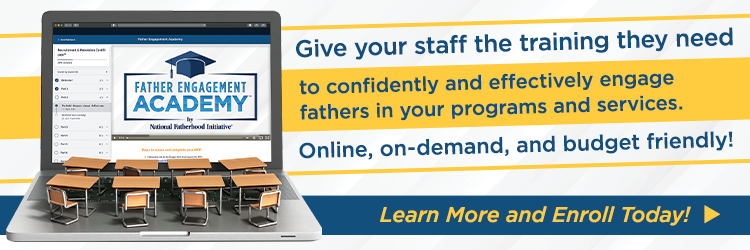
Last week, my colleague and friend Erik Vecere wrote in this blog about the benefits of dads reading to their children. He shared four ways you can help dads engage in this vital activity.
This article builds on Erik’s by encouraging you to help dads use shared book reading with their children, a practice that research shows is particularly helpful for the development of children’s literacy skills and healthy relationships between parents and their children.
Dr. Laura Cutler and Dr. David Palkovitz, two of the nation’s leading experts on shared reading, define the practice and its benefits this way:
What’s shared reading? And what are its benefits?
“Shared book reading occurs when an adult—typically a family member or caregiver—reads to and with a child. This is a common practice for many families across the world. Familial shared book reading is important for many reasons: It introduces young children to print concepts such as book orientation and reading direction, promotes a range of early language and literacy skills in children, and helps develop positive relationships between caregivers and children.”
As Erik points out, dads tend to read to their children differently than moms do, and that’s great for children. Drs. Cutler and Palkovitz explain that this dad-specific benefit results from dads doing the following:
- Asking more open-ended questions, which challenges children’s thinking and expands their language
- Engaging in more challenging conversations
- Engaging in more parent-child interlocking contact (mutual touching)
Despite this dad-specific benefit, dads are less likely than moms to read to their children. Fortunately, as Drs. Cutler and Palkovitz point out, this gap has narrowed recently as dads have become more involved generally in a range of caretaking behaviors.
Still, dads need a nudge every now and then to read to and with their children. That’s where you come in. In addition to the four ways Erik mentions you can help dads read to their children, here are six more from the aforementioned Drs. (for a whopping 10 ways) that will create an environment that nudges dads along:
- Normalize and promote dad-child shared book reading as a vital activity
- Highlight the unique contributions of dads reading to their children
- Stress the importance of sharing books rather than being a “perfect” reader
- Feature dads in messages and marketing materials promoting reading and other family literacy activities
- Provide and recommend books of interest to a diversity of dads, that take into account varying literacy levels of dads, and that feature dads interacting with their children in positive ways
- Provide and recommend books that portray a diversity of dads in background (e.g., race, ethnicity, and culture) and family structures (e.g., married, single, adoptive, and step)
Finally, here are some additional resources for you and the dads you serve that build on the resources Erik provides:
Do you promote shared book reading with the dads you serve?
Do you identify whether the dads you serve have children with a reading disability and, if so, provide those dads with help reading to their children?
